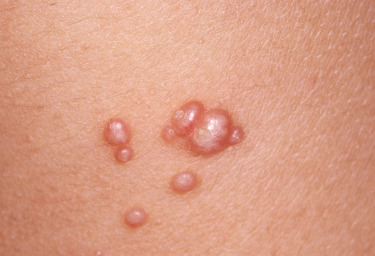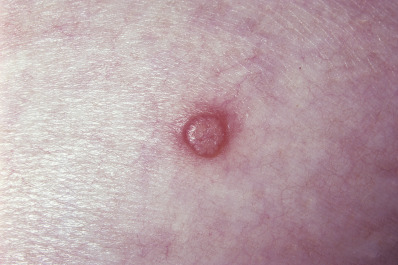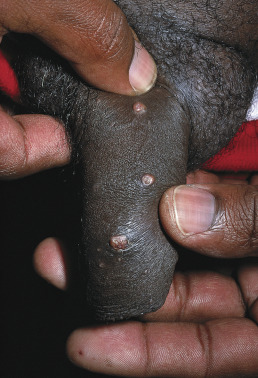AUTHOR: Fred F. Ferri, MD



DefinitionMolluscum contagiosum (MC) is a DNA poxvirus characterized by discrete skin lesions with central umbilication. It predominantly affects children.
SynonymMC
| ICD-10CM CODE | | B08.1 | Molluscum contagiosum |
|
Epidemiology & Demographics
- Peak occurrence ranges from 2 to 5 years, with an estimated overall prevalence of 2.8% among children.
- The disease tends to occur in epidemics, characteristically targeting childcare centers, swimming pools, and schools.
- Molluscum contagiosum spreads by autoinoculation, scratching, or touching a lesion.
- It usually occurs in young children. It is also common in sexually active adults and patients with HIV infection.
- Incubation period varies between 4 and 8 wk.
- Spontaneous resolution in immunocompetent patients can occur after several months.
Physical Findings & Clinical Presentation
- The characteristic lesions appear as flesh-colored, domed papules with central umbilication that may present anywhere on the body surface, including the genitalia in sexually active individuals. The individual lesion appears initially as a small (2 to 3 mm), flesh-colored, firm, smooth-surfaced papule with subsequent central umbilication. Lesions are frequently grouped (Fig. 1). The size of each lesion generally varies from 2 to 6 mm in diameter.
- Typical distribution in children involves the face, extremities, and trunk. Mucous membranes are spared.
- Distribution in adults generally involves pubic and genital areas (Figs. E2 and E3).
- Severe, diffuse involvement may be seen in patients with immunosuppression, including human immunodeficiency virus (HIV) infection.
- Erythema and scaling at the periphery of the lesions may be present as a result of scratching or hypersensitivity reaction.
- Lesions are not present on the palms and soles.
Figure 1 Grouped molluscum.

From Kliegman RM et al: Nelson textbook of pediatrics, ed 19, Philadelphia, 2011, Saunders.
Figure E2 Molluscum contagiosum.

From James WD et al: Andrews’ diseases of the skin, ed 12, Philadelphia, 2016, Elsevier.
Figure E3 Molluscum contagiosum of the penis.

From James WD et al: Andrews’ diseases of the skin, ed 12, Philadelphia, 2016, Elsevier.
EtiologyViral infection of epithelial cells caused by a poxvirus, molluscum contagiosum

Diagnosis is usually established by the clinical appearance of the lesions (distribution and central umbilication). A magnifying lens can be used to observe the central umbilication. If necessary, the diagnosis can be confirmed by removing a typical lesion with a curette and examining the content on a slide after adding potassium hydroxide and gentle heating. Staining with toluidine blue will identify viral inclusions.
Differential Diagnosis
- Verruca plana (flat warts): No central umbilication, not dome shaped, irregular surface, can involve palms and soles
- Herpes simplex: Lesions become rapidly umbilicated
- Varicella: Blisters and vesicles are present
- Folliculitis: No central umbilication, presence of hair piercing the pustule or papule
- Cutaneous cryptococcosis in AIDS patients: Budding yeasts will be present on cytologic examination of the lesions
- Basal cell carcinoma: Multiple lesions are absent
- Cellulitis
WorkupCareful examination of the papules
Laboratory TestsGenerally not indicated in children.
- Dermoscopy to confirm the presence of the characteristic amorphous, lobular, yellow central umbilication
- Methylene blue smear preparation to identify molluscum bodies
- Histopathology to identify eosinophilic intracellular inclusion bodies (Henderson-Paterson bodies)
These investigations are required only when the diagnosis is in doubt.
Screening for other sexually transmitted diseases is recommended in all cases of genital molluscum contagiosum.


